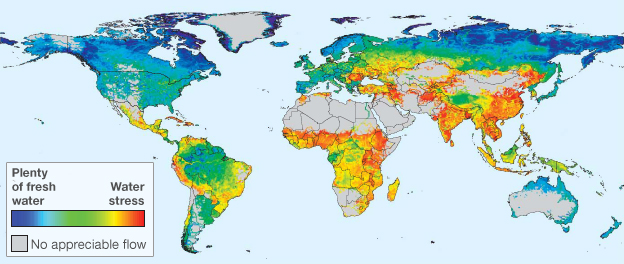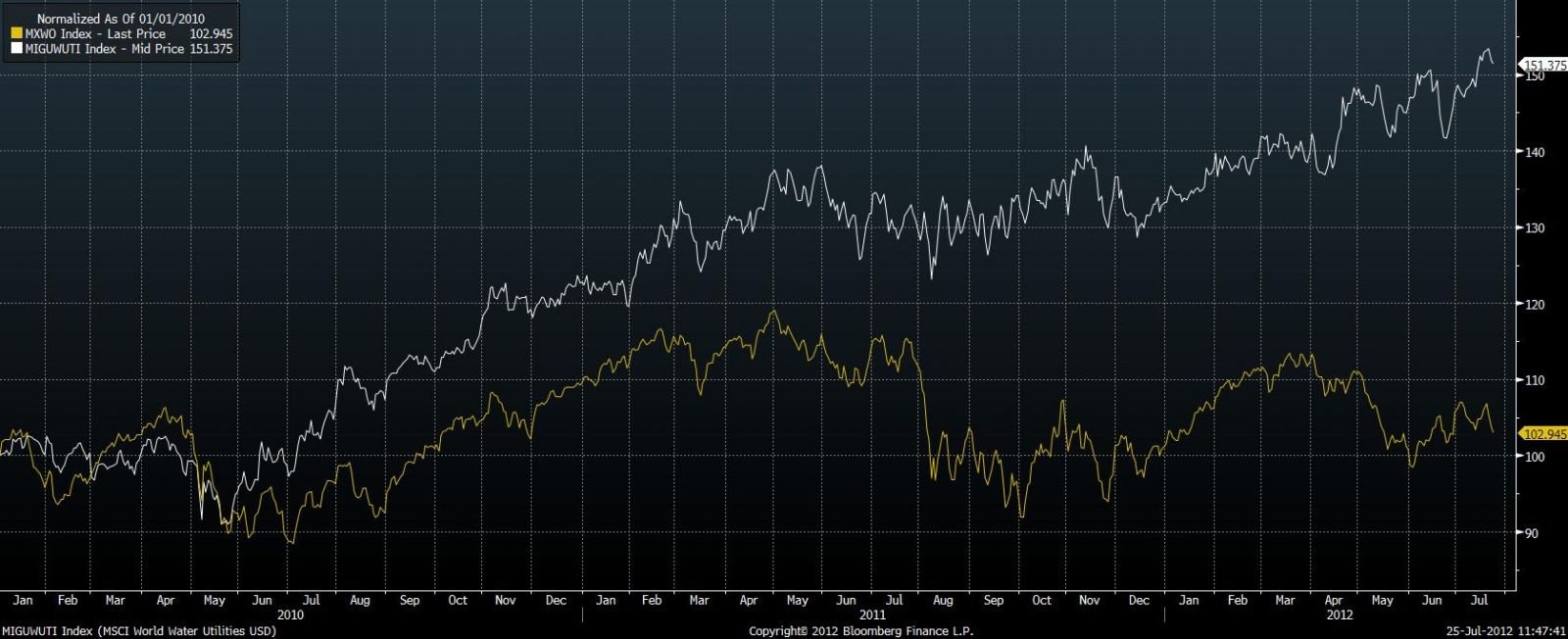The water is a limited commodity and essential to life.
While it seems trivial, a priori, it is important to remember this : water is essential to life. Thus, with the air, it is the only commodity to have an infinite intrinsic value. On the one hand, water has no possible substitute. Moreover, its supply is fixed. It is impossible to increase it : there will always be 1.4 billion cubic kilometers of water on earth[1]. Only 0.014% of this amount is drinking water easily accessible.
More and more people on earth
Currently, there are about 7 billion people on Earth and some are dying of thirst. By 2030, there will be 8.32 billion people and 9.31 billion in 2050[2]. This population growth is a strong pressure on demand for potable water. Human beings need it for drinking, but also for agriculture, for industry, for domestic use, etc.

The first map above shows the "raw threats" to people's water security in the world. The second shows the impact of the infrastructure that distributes and conserves water[3].
For example, France, in red on the first map and in green on the second, has a lot of raw threats but thanks to its infrastructure, the country has no water shortage.
Conversely, Madagascar, in green on the first map and in yellow on the second, has sufficient resources but does not have the capacity to exploit them.

An imbalance between demand and supply
Thus, there is an imbalance between limited supply and increasing demand for drinking water. In the same vein, some parts of the world have surplus resources while others are experiencing large shortages. To try to balance demand and supply, many technologies are developed to exploit new sources of water (and specially drinking water). One way being considered is desalination of seawater. Although this sector is growing strongly, it is energy-intensive and high-polluting. Another way, probably more promising, is the treatment of wastewater and polluted water because it is less expensive. However, to do so, a country must already have unsalted water, which explains why the Middle East countries prefer to invest in desalination.
Anyway, the price of drinking water is set to rise : either the pressure of demand drives up prices ; either new technology has high costs that affect the price of blue gold.
How to invest in water?
There are many ways to be exposed to water related industries. To put it simply, there are three main possible investments: water utilities, water bottles and water ETFs.
The water utilities industry consists of all water that is collected, treated and distributed to agricultural, industrial, and residential end-users. In 2010, it had a value of 657 billon dollars[4]. Analysts expect an acceleration of growth through 2015 to 824.3 billion dollars with a 4.6% average annual growth rate. In Europe, the two major players are Veolia and Suez. There is also United Utilities in the UK. For investors who prefer the American continent, Flowserve or ITT are options to consider. Finally, companies such as Guangdong Investment in Asia can perform.
The bottled water industry also offers good prospects. In 2010, it generated 99.3 billion dollars of revenues. Analysts forecast growth above 27% by 2015. The market is dominated by large companies such as Danone (14.1% market share), Nestlé (13.6%) or The Coca-Cola Company (8.4%). The competition is very fierce because water is the same in all bottles.
Finally, investors can also be interested in water ETFs. These help to diversify risk and invest easier. There are a large number of ETFs in this industry. Invesco PowerShares, as Pictet, First Trust or Investment Guggenheim offer some opportunities.
If you want to find other potential investments, do not hesitate to use 4-traders market screener here.

Above : a graph showing the performance of the MSCI World Index (in yellow) and MSCI World Water Utilities Index (in white).
Thus, water is the new (blue) gold for years to come. Investing in it is part of a long-term strategy that could be highly lucrative.
Today, investors can already speculate on CO2 with the European Union Emissions Trading System (EU ETS). When will it be the case for H2O?
Follow @MMarksJr

 By
By 





















